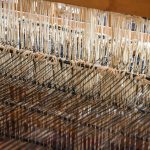You rely on ballistic Kevlar fabric because its tightly woven polyamide fibers create a molecular structure that resists stretching and breaking under impact. When a bullet strikes, Kevlar absorbs and disperses the energy across its strong, flexible layers, preventing penetration and reducing blunt trauma. The fibers also catch fragments, adding protection without heavy bulk. Its advanced manufacturing guarantees durability and strength unmatched by other materials. Keep exploring to uncover more about how Kevlar keeps you safe.
Table of Contents
Key Takeaways
- Kevlar’s molecular chains align tightly, creating strong hydrogen bonds that provide exceptional tensile strength and resistance to stretching and breaking.
- The fabric’s tightly woven fibers absorb and disperse ballistic energy, preventing force concentration and reducing projectile penetration risk.
- Kevlar fibers stretch slightly upon impact, slowing projectiles while maintaining structural integrity to minimize damage and blunt trauma.
- Manufacturing includes spinning, heat-treating, twisting fibers into yarns, and weaving them tightly for maximum strength and durability.
- Compared to steel and ceramic, Kevlar offers superior strength-to-weight ratio, flexibility, and heat resistance, making it ideal for lightweight bulletproof protection.
The Molecular Structure of Kevlar
Although you mightn’t see it, Kevlar’s strength comes from its unique molecular structure.
When you look closer, you’ll find that Kevlar is made of long chains of molecules called polyamides. These chains align parallel to each other, creating strong hydrogen bonds between them. This alignment forms tightly packed, crystalline regions, which give Kevlar its incredible tensile strength.
You can think of these chains like tightly woven threads in a fabric, but on a molecular level. This structure makes Kevlar extremely resistant to stretching and breaking. Plus, the rigidity of the molecular chains prevents deformation under stress.
How Kevlar Absorbs and Disperses Impact Energy
When a ballistic impact strikes Kevlar fabric, its tightly woven fibers quickly absorb and spread the energy across a wide area.
You’ll notice that this distribution prevents the force from concentrating in one spot, reducing the chance of penetration. The fibers work together, stretching slightly to slow down the projectile while maintaining their strength.
As the energy disperses, the layers of Kevlar catch and trap fragments, further minimizing damage. You can think of it as a high-speed tug-of-war, where each fiber pulls against the force, sharing the load.
This dynamic response not only stops bullets but also lessens blunt force trauma, keeping you safer.
Kevlar’s unique interplay of strength and flexibility makes it an effective barrier against ballistic threats.
Manufacturing Processes of Ballistic Kevlar Fabric
Understanding how Kevlar absorbs and spreads impact energy helps you appreciate the care and technique behind its production.
The manufacturing process transforms raw Kevlar fibers into a fabric capable of stopping bullets. You start with spinning the polymer solution into fibers, which then undergo heat treatment to enhance strength.
Next, these fibers are twisted into yarns and woven tightly to maximize resistance. Finally, the fabric gets coated or laminated for durability and water resistance.
Key steps include:
- Spinning polymer into fibers
- Heat-treating for enhanced strength
- Twisting fibers into high-tensile yarns
- Weaving yarns into dense, tight fabrics
- Applying coatings for durability and moisture protection
Each step guarantees the fabric performs reliably under extreme conditions.
Comparison Between Kevlar and Other Protective Materials
Since you want reliable protection, comparing Kevlar with other materials helps you see why it’s often the top choice. Kevlar stands out for its exceptional strength-to-weight ratio, flexibility, and resistance to heat and impact. Unlike steel or ceramic, Kevlar offers lightweight comfort without sacrificing durability.
| Material | Weight | Flexibility | Impact Resistance |
|---|---|---|---|
| Kevlar | Light | High | Excellent |
| Steel | Heavy | Low | Very Good |
| Ceramic | Moderate | Low | Excellent |
| UHMWPE* | Very Light | Moderate | Good |
*Ultra-high-molecular-weight polyethylene
Choosing Kevlar means balancing protection with comfort, making it ideal for diverse protective gear where mobility matters.
Real-World Applications of Ballistic Kevlar in Safety Gear
Kevlar’s unique combination of strength and flexibility makes it a go-to material for various types of safety gear.
Kevlar blends strength and flexibility, making it essential for reliable safety gear across many uses.
When you wear Kevlar-based equipment, you benefit from superior protection without sacrificing comfort or mobility.
This fabric’s real-world applications include:
- Bulletproof vests for law enforcement and military personnel
- Motorcycle jackets that protect against abrasions and impacts
- Fire-resistant gloves and suits for firefighters
- Helmets with Kevlar layers for enhanced ballistic resistance
- Protective inserts in backpacks to guard against stabbings and gunfire
Frequently Asked Questions
How Does Temperature Affect Kevlar’s Ballistic Performance?
You’ll find that extreme temperatures can weaken Kevlar’s ballistic performance. Heat may reduce its strength and stiffness, while cold can make it more brittle, so its protective abilities might not be as reliable in harsh conditions.
Can Kevlar Be Recycled or Reused After Impact?
Did you know Kevlar can lose up to 50% of its strength after impact? You can’t recycle it traditionally, but you can repurpose used Kevlar for less critical gear or composite materials, extending its life smartly.
What Are the Environmental Impacts of Producing Kevlar?
You’ll find producing Kevlar uses significant energy and chemicals, which can harm the environment. While it’s durable, the manufacturing process emits pollutants, so you should consider sustainability when deciding to use or produce it.
How Long Does Ballistic Kevlar Fabric Last Under Regular Use?
You might accidentally spill coffee while checking your gear, but don’t worry—ballistic Kevlar lasts about five to seven years under regular use. Just keep it dry and avoid heavy abrasion to maintain its strength.
Are There Health Risks Associated With Handling Kevlar Fibers?
You won’t face major health risks handling Kevlar fibers, but avoid inhaling dust or fibers, as they can irritate your skin, eyes, or lungs. Wearing gloves and a mask helps keep you safe during handling or cutting.
- Choosing the Right Fabric: When to Use Poly-Cotton Over 100% Polyester - June 23, 2025
- The Difference Between 60/40 and 50/50 Cotton Polyester Blends - June 23, 2025
- Is Cotton Polyester Fabric Good for Summer? An Honest Review - June 23, 2025






